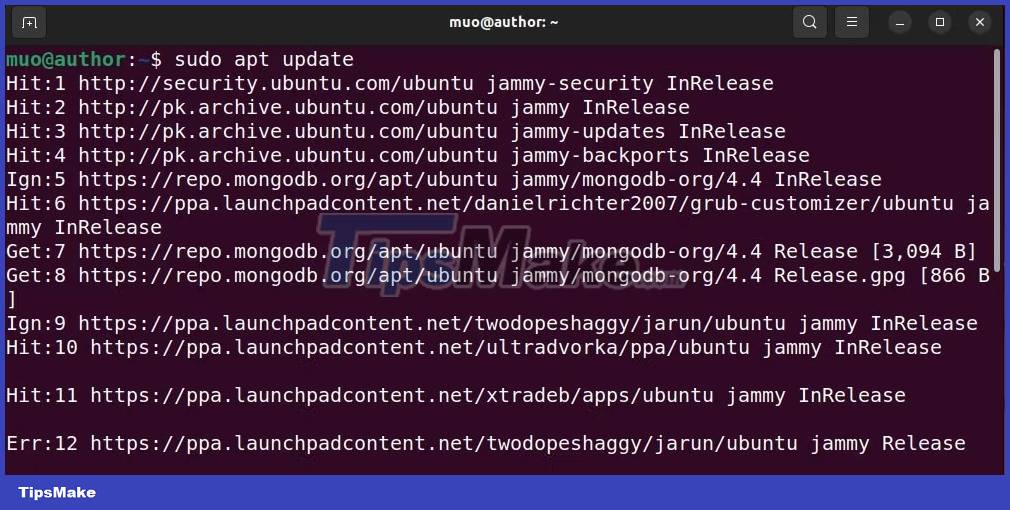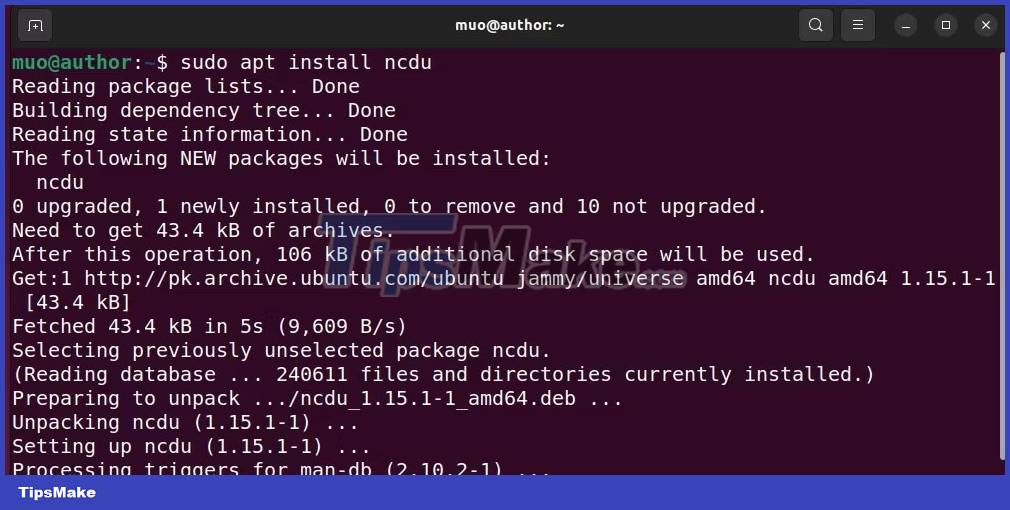How to use ncdu to check disk space in Ubuntu
If so, you'll want to see how the ncdu command can help solve this problem.
Here's how to use ncdu to check disk space usage on Ubuntu and make disk space management an easy task.
Prerequisites: Install ncdu on Ubuntu
First, open terminal and update your system package information:
sudo apt update

Next, install ncdu on your Ubuntu system:
sudo apt install ncdu

To check if you can now run ncdu, just display its version:
ncdu -version

How to use ncdu on Ubuntu
ncdu is a modern replacement for the classic du command. This utility helps you analyze the disk usage of any folder.
Let's explore some practical use cases of the ncdu command.
1. Check the disk usage of the current folder
Running ncdu without any options displays the current directory's drive usage:
ncdu

2. Display subfolder details
To select a subfolder, you can use the up and down arrow keys. Then, press the i key to check the information of that subfolder such as Name, Path, Type, Disk usage and Apparent size:

3. Navigate to a specific subfolder
To navigate to the selected subfolder, simply press the right arrow key:

View relevant drive usage details and press the left arrow key to switch back to the parent folder.
4. Check the disk space of the root directory
To check the disk usage of the root directory, use the -x option with a forward slash /.
sudo ncdu -x /
The -x option instructs ncdu to only include files on the same file system:

The ongoing scan will take a few seconds to complete and then display the results:

5. Check the disk usage of a specific folder
To visualize the disk usage of any given folder, specify the relative or absolute path, just like you did with the root folder. For example:
ncdu ~/snap

By mastering ncdu, you can easily test and manage your memory, which makes your Ubuntu experience more efficient. So, take control of your system's efficiency and organization, and implement these tips to enjoy an optimized Ubuntu experience like never before.
You should read it
- How to check available memory in Ubuntu
- Ways to install Ubuntu on Windows, run in parallel or run separately
- Check out the most interesting features in Ubuntu 12.10
- How to install Ubuntu in parallel with Windows using USB
- Why is Ubuntu LTS preferred over regular distros?
- What's new in Ubuntu 18.04 LTS just released?
- How to prolong the life of Ubuntu 18.04 installation with Ubuntu Pro
- What is the difference between Ubuntu Desktop and Ubuntu Server?
May be interested
- How much disk space does Windows 10 take?
 how much disk space does windows 10 ?. in 2016 when it debuted, windows 10 was very compact, lightweight when they weighed only 16gb for 32-bit windows and 20gb for 64-bit versions of windows. but since 2016, windows 10 has gone through dozens of different updates, so they will have the following capacity changes:
how much disk space does windows 10 ?. in 2016 when it debuted, windows 10 was very compact, lightweight when they weighed only 16gb for 32-bit windows and 20gb for 64-bit versions of windows. but since 2016, windows 10 has gone through dozens of different updates, so they will have the following capacity changes: - What's New in Ubuntu 21.10?
 version 21.10 is the latest release of ubuntu and although canonical is turning more attention to the cloud and developers, ubuntu 'impish indri' still comes with some notable changes for those users use the ubuntu desktop every day.
version 21.10 is the latest release of ubuntu and although canonical is turning more attention to the cloud and developers, ubuntu 'impish indri' still comes with some notable changes for those users use the ubuntu desktop every day. - How to install Ubuntu in parallel with Windows using USB
 installing ubuntu in parallel with windows 7 and 8 with usb will help users not to waste time writing files to disk, running on many different computers.
installing ubuntu in parallel with windows 7 and 8 with usb will help users not to waste time writing files to disk, running on many different computers. - How to clean up junk files to reduce disk space C
 how to clean up junk files to reduce disk space c. after a long time using the computer, temporary files will generate junk files and take up hard disk space, sometimes they will make our computer work. no longer as smooth as before. we should correspond
how to clean up junk files to reduce disk space c. after a long time using the computer, temporary files will generate junk files and take up hard disk space, sometimes they will make our computer work. no longer as smooth as before. we should correspond - Disk Quotas configuration in Windows 2003
 are you looking for means of managing storage space allocated to users? you can use disk quotas. this article gives you an overview of disk quota in windows 2003. we have reviewed the reasons why ch & u
are you looking for means of managing storage space allocated to users? you can use disk quotas. this article gives you an overview of disk quota in windows 2003. we have reviewed the reasons why ch & u - How to Free up Hard Disk Space on Windows Vista
 as the windows vista os becomes more entrenched in the market, fewer users will look towards older operating systems. this guide will present a range of methods to troubleshoot a lack of hard disk space your computer may suffer from; vista...
as the windows vista os becomes more entrenched in the market, fewer users will look towards older operating systems. this guide will present a range of methods to troubleshoot a lack of hard disk space your computer may suffer from; vista... - How to access user activity on Linux
 if you are using a linux server, you can use the following commands to check user activity - when system users log in and frequency of use, which group they belong to, and how much disk space they are currently running. consumption, what command are they running, how much disk space is taking up, ...
if you are using a linux server, you can use the following commands to check user activity - when system users log in and frequency of use, which group they belong to, and how much disk space they are currently running. consumption, what command are they running, how much disk space is taking up, ... - Best application to help recover disk space
 spacesniffer has the ability to analyze hard drive and folder structure in an impressive and fast way that no other application can do the same.
spacesniffer has the ability to analyze hard drive and folder structure in an impressive and fast way that no other application can do the same. - Check and fix hard drive errors with chkdsk on Windows
 whenever there is a hard drive error or even strange behavior, users can rarely think of check disk as 'savior'. this article will show you how to use the check disk tool that comes with all versions of windows.
whenever there is a hard drive error or even strange behavior, users can rarely think of check disk as 'savior'. this article will show you how to use the check disk tool that comes with all versions of windows. - Why is Ubuntu LTS preferred over regular distros?
 ubuntu is one of the most widely used linux distributions among software developers and other content creators. ubuntu is also used for many servers around the globe.
ubuntu is one of the most widely used linux distributions among software developers and other content creators. ubuntu is also used for many servers around the globe.










 How to run a program periodically using the Watch command on Linux
How to run a program periodically using the Watch command on Linux How to Install XAMPP on Linux
How to Install XAMPP on Linux How to Install Ubuntu on VirtualBox
How to Install Ubuntu on VirtualBox Is it possible to run .exe files on Linux?
Is it possible to run .exe files on Linux? How to Install Tor on Linux
How to Install Tor on Linux How to Install Linux
How to Install Linux